When someone points at a plant and reels off it's official Latin Name, you may be impressed or think they are showing off (we won't judge you, either reaction has its place).
The fact of the matter is that the Latin Name of a plant is pretty universal across the world, no matter what language you speak a Spathiphyllum will always be a Peace Lily (assuming that's the Common Name you know it by of course!).
It really is worth understanding plant names, so grab our hand and together let's go back to basics and make the whole thing simple. First up, a quick history lesson.
The Greek philosopher Theophrastus (Theo to his friends) spent a lot of his time studying and writing about plants, his two most important works involved with this are Enquiry into Plants and On the Causes of Plants.
In order for people reading his work to be able to understand what he was talking about, he illustrated many of the plants and gave them names. His work was some of the most important contributions to botanical science during antiquity and the Middle Ages.
If Theophrastus laid the basic stepping stones over the murky river of plant identification, Carl Linnaeus built the epic suspension bridge across.

Carl Linnaeus Portrait
With respect to Theophrastus, his naming choices were odd and sometimes confusing, Linnaeus' work Species Plantarum tore up the rule book and laid out a simple, clear and scientific ordering that still exists today.
So that's the history sorted out, let's look at Linnaeus way of doing things one step at a time and we promise it's easy.
To demonstrate this simply we are going to use one group of plants throughout this entire article in this case Dracaena.
The Latin, Scientific or Botanical name for the Madagascar Dragon Tree is Dracaena marginata, this can be broken down in the following diagram.
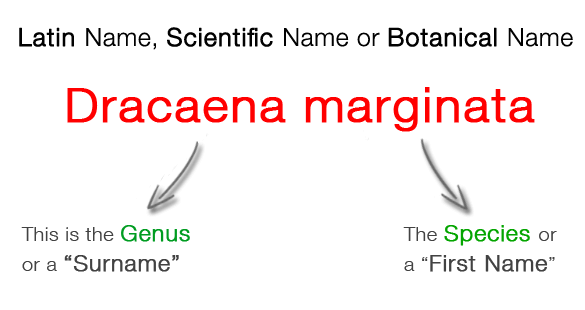
The illustration above summaries things with an easy example. The Latin Name for a plant is basically a person's full name i.e. John Smith but written backwards.
So essentially the Genus is the surname (Smith), whereas the Species is the Christian or first name (John). Unlike people however, only one plant in the entire world can have this name which means it is truly unique.
Once used fully in a book, or on a website page like this, the correct way to continue writing the Latin Name is to abbreviate the Genus to its first letter, full stop and then the Species all in lowercase. i.e. Dracaena marginata becomes D. marginata.
We won't do this here, but this may be helpful in understanding why plant names are sometimes written like this, especially in more formal texts.
Many different Dracaena's make great indoor plants and therefore you could grow a large number of these as houseplants. Every one of these plants would still belong to the Dracaena Genus, thus when you describe this plant using the Latin Name it would always start with "Dracaena".
The picture below shows lots of different Dracaena's that are all grown as houseplants.
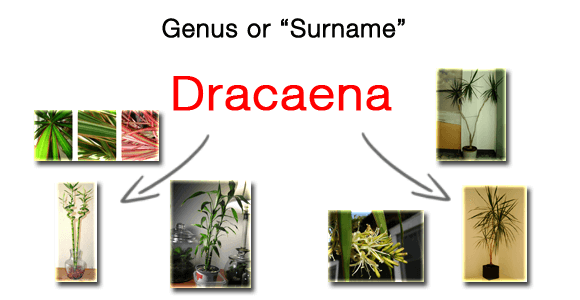
To explain Species, let's pretend there is a family who live down your street with the surname "Smith". When you can see them in person you know who is who by sight alone, but if you had to identify them to a stranger beyond simply saying "The Smith Family" and didn't know their individual names it would be much harder and take a lot longer.
Remember from the very first example, that the Species of a plant is basically the equivalent of a persons first name. So the Smith family all have different first or Christian names to distinguish themselves from one another and this is exactly the same with plants.
The only difference for plants is that it's always backwards. The surname first then the Christian name.
Pretending the Smiths are actually plants they would then be known as "Smith John", "Smith Joan". With our Dracaena example it's "Dracaena marginata". With John, Joan and marginata being the Species.
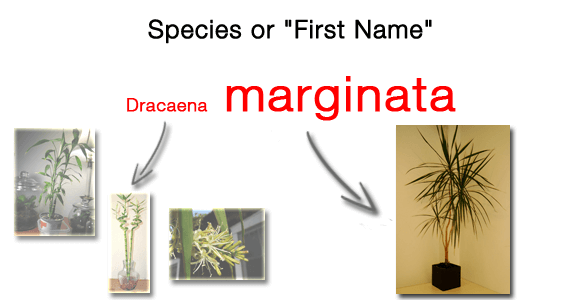
Although all plants are unique, there are times when they are very similar genetically or visually, too similar to have their own individual Species name.
In these cases the Scientific name expands to at least three words i.e. Dracaena marginata "tricolor". This tells you that the plant is a member of the Dracaena Genus, and is also part of the marginata Species, however it is differentiated from the original marginata by its "tricolor" name.
In this case the tricolor variety has the exact same growth patterns as the ordinary marginata, except the leaf colour is different.
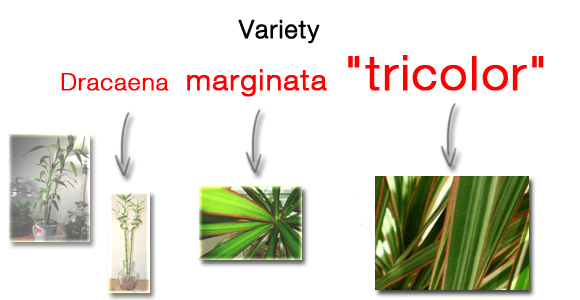
If the Variety was created in cultivation and it did not exist in nature originally, then it's called a Cultivar, this is short for Cultivated Variety.
The way to know if a plant is a Cultivar is to look at the name itself, it will usually not be in Latin, whereas a true natural Variety will almost always be in Latin.
Looking at Dracaena marginata "colorama" this indicates that because "colorama" is not a Latin word, it never existed out in the wild and it was instead created by botanists through selective breeding and crossing i.e. a Cultivar.
In the above examples we have been working "downwards" or "forward" in sequence through the Latin / Scientific / Botanical Name start to finish. When we look at a Family we go all the way back to the start and then one step back again.
The Dracaena Genus links to several other plant Genuses because each one has similar characteristics.
A good way to think about this is to pretend you're at a family party with distant cousins. You and your cousins only resemble each other slightly when comparing similarities with your brothers or sisters where you can see you have much more in common. However if you look hard enough at your distant cousins you will find common genes that link you together as a Family.
When it comes to the Dracaena Genus it falls into the Asparagaceae Family. A few other members include Chlorophytum (Spider Plant), Sansevieria (Mother-In-Law's-Tongue) and Yucca. If you look at these plants closely you will start to see parts that resemble one another.
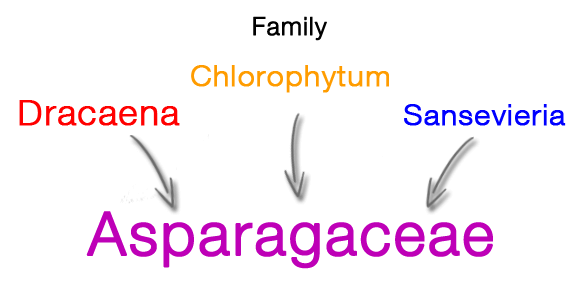
The Common Name is usually created culturally and can genuinely be quite interesting. The Latin is normally completely stripped out and you are left with a name that either describes the plants appearance in some way or something that it "does". Other times the Latin may remain but in a condensed or simpler form.
Often the name is stepped in custom and history which can make uncovering a plants Common Name fun. For example the "Dragon Tree" is so named because Dracaena in English translates to "She Dragon". The leaves also grow on top of canes which resemble skinny tree trunks.

Chlorophytum is known as the Spider Plant the Bad Mother Plant, Ribbon Plant, Airplane Plant and St Bernard's Lily.
Chlorophytum, as another example, tends to go by the name "Spider Plant" because its growth resembles that of a Spider. But in Mexico it is know as the "Bad Mother Plant" because of the way it "throws" its babies away from itself.
The Victorians called it the "Ribbon Plant" because the leaves resemble ribbons and others still call it the "Airplane Plant" or "St. Bernard's Lily". Each name has been popular at one time or another and highlights how important a relationship we have with our houseplants.
- Generally plant Latin Names are "fixed", however they can sometimes be changed. You may be able to appreciate that if a Genus has been used by many people for a period of time, then for it to suddenly be changed can cause considerable confusion.
For example Scindapsus has now become Epipremnum (Pothos). Sansevieria (Snake Plant) has changed to Dracaena.
- Not everyone speaks or uses the Latin Names when talking about plants. Science may, but the average plant owner doesn't and will instead use a Common Name which is recognised in that part of the world.
Locally that might be perfect, however not when your audience is spread over a large area. For example when we came to write the plant profile for the Alocasia we needed to decide whether to call it the Kris Plant or Elephant Ear. Both are equally valid in different parts of the world, although if we focused on one we may have confused those who call it by a different name.
And that is pretty much it. It can get more complex but this is as difficult as we get on our site. What follows is a summary of each term and a example of when you may use it in a sentence.
Family - Is a large group of plant Genuses which have similarities to one another.
In a sentence - "Dracaena and Chlorophytum are members of the Asparagaceae Family".
Genus - Similar plants which are very closely related are given a Genus.
In a sentence - "The Dragon Tree and Lucky Bamboo are part of the Dracaena Genus ".
Species - Within the Genus group each different plant is known as a Species
In a sentence - "The Dragon Tree is a species of Dracaena".
Variety - Species which are very similar have different Varieties
In a sentence - "The Dragon Tree 'Tricolor' is a variety of the standard Dragon Tree".
Cultivar - If the Variety was created by science rather than nature it is a Cultivar.
In a sentence - "The Dragon Tree 'colorama' is a Cultivar".
Latin Name - The official Scientific, or Botanical name of a plant.
In a sentence - "Dracaena marginata is the Latin name for the Dragon Tree ".
Common Name - The usual or popular name a plant goes by in your culture.
In a sentence - "The Dragon Tree is the common name for Dracaena marginata".

Hi, I'm Tom!
If you're like me and enjoy the challenge of growing houseplants and getting them to thrive, then Ourhouseplants can help. This website shares my knowledge and years of growing plants and provides (hopefully) helpful advice on properly caring for your indoor plant friends.